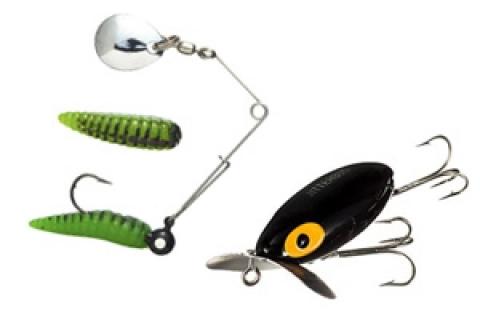
The Jitterbug and Beetle Spin — a pair of time-tested lures.
 |
| Since 1938, the Jitterbug drives largemouths wild as a topwater bait. |
The Jitterbug
Born in Akron, Ohio, in 1893, Fred Arbogast became a competitive caster and won several world titles. It was in lure-making, though, that he left his biggest mark. Two of his most important creations were the Hawaiian Wiggler and Hula Popper. Few lures, however, were as original or enduring in appeal as the Jitterbug, a wobbling surface plug with a wide metal lip named after the dance craze of the time.
Arbogast had originally tried to make a diving plug when he began working on the Jitterbug. He failed miserably in that, but the final product, introduced in 1938, created a hypnotic, gurgling sound on the retrieve that drove largemouths wild as a topwater bait. Smashing strikes greeted the new plug wherever it was cast, and the lure remains a staple item today in the tackle boxes of serious bass fishermen. It's particularly favored for fishing at dusk and dawn as well as at night on a calm lake.
Tactics
You can twitch the Jitterbug erratically and draw fish out of lily pads and stumps, but the most consistent retrieve is usually slow to moderate and steady. I like yellow and frog versions during the day. At night go with black so it shows up well against the light sky background. Try the biggest Jitterbug model for taunting huge muskies, pike and jumbo bass, the one-eighth ounce version for river smallmouths.
 |
| The Beetle Spin is a classic for catching river smallmouths, bluegills, crappie, among others. |
The Beetle Spin
When Virgil Ward set out to create a new lure back in 1948, he had no intention of marketing his product. Like many other lure inventors, he simply wanted to be able to catch more fish.
The modern Beetle Spin has changed little in over 65 years since it was created. The same safety-pin spinner design, small Colorado blade and round jig head are used. Only the body is made of a slightly softer material to give it a livelier action.
This is a classic lure for catching river smallmouths, bluegills, crappies, rockbass, white bass, white perch and other panfish. In larger sizes, it's also great for walleyes, largemouths, pickerel and northern pike. It's become a legend for many reasons, but one of the main ones is that it's so easy to fish. A simple steady retrieve with a Beetle Spin will catch almost any fish that swims.
Tactics
Cast into pools, pockets and eddies in rivers; coves, points, rock piles and wood cover in lakes. Let the Beetle Spin sink near the bottom, watching the line for strikes on the drop. Then retrieve steadily. That's all there is to it. The lure's thumping, fluttering action will do the rest.
- 6209 views

